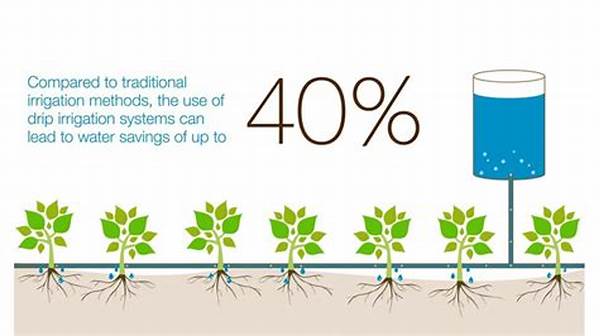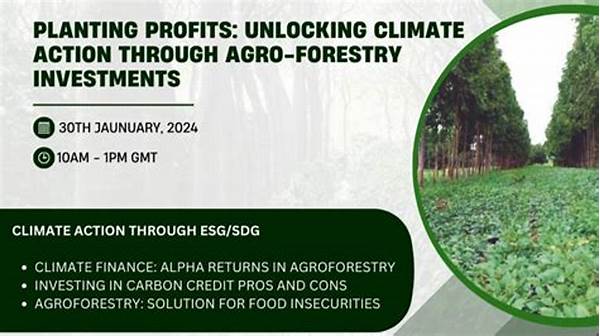In today’s world, where the scarcity of clean water is a looming threat, the importance of conserving this precious resource cannot be overstated. Agriculture, being one of the most water-intensive activities, demands a sustainable approach to irrigation. This is where the revolutionary method of drip irrigation comes into play, effectively reducing water wastage while boosting crop yields. By pinpointing water application directly to the plant roots, drip irrigation reduces evaporation and runoff, making it an indispensable tool for farmers aiming to improve water efficiency.
Read Now : Biodiversity In Farming Landscapes
How Drip Irrigation Works for Water Conservation
Drip irrigation, a method that efficiently delivers water to the plant’s root zone, significantly reduces water wastage. Unlike traditional flood irrigation, drip systems utilize a network of tubing and emitters to apply water gradually and precisely. This ensures that water is properly absorbed by the soil, maintaining a consistent moisture level. Consequently, this precise application minimizes evaporation, and water is conserved in the process. Moreover, nutrients are better retained in the soil, further promoting healthy plant growth and resource conservation. Drip irrigation is a game-changer for modern agriculture, offering a sustainable solution that can meet future water management demands without compromising agricultural productivity.
The Advantages of Drip Irrigation in Combating Water Wastage
1. Precision and Efficiency: Drip irrigation provides targeted water delivery, reducing unnecessary runoff and ensuring that each drop contributes to plant growth. This precision leads to an increase in water efficiency.
2. Minimized Evaporation: Water is directly applied to the roots, dramatically reducing evaporation rates. This method conserves more water compared to surface-based irrigation methods.
3. Reduced Water Footprint: Utilizing drip irrigation can shrink the overall water footprint of agricultural practices, making it a cornerstone of sustainable farming.
4. Enhanced Nutrient Retention: By maintaining moisture at optimum levels, drip irrigation allows for better retention of soil nutrients, reducing the need for additional fertilizers.
5. Scalable and Adaptable: This system can be scaled and adapted to various land sizes and crop types, making it a versatile solution for reducing water wastage across diverse farming practices.
Environmental Impact of Drip Irrigation
As we face heightened environmental challenges, drip irrigation proves to be an effective weapon against water wastage. Its ability to deliver water directly to the plant root zone ensures minimal waste and promotes soil health. This method conserves water resources, crucial in drought-prone regions, where every drop saved counts significantly towards sustainability. By reducing dependency on excessive water extraction, drip irrigation supports the replenishment of local water bodies, fostering a balanced ecosystem. Additionally, it diminishes soil erosion and nutrient leaching, ensuring long-term soil fertility and agricultural productivity. Adopting this technology globally could significantly alleviate the water crisis.
Farmers implementing drip irrigation report substantial reductions in water usage, leading to cost savings and increased crop yields. This contribution to economic sustainability is noteworthy, as resources saved from water conservation can be reinvested into improving farm infrastructure. Furthermore, the promotion of drip irrigation techniques encourages innovation, empowering communities to adopt sustainable practices. The global agricultural sector, empowered by drip irrigation, can achieve a harmonious balance between resource use and environmental conservation. Ultimately, drip irrigation reducing water wastage is a vital step towards securing a more sustainable future for agriculture worldwide.
Implementing Drip Irrigation Systems
Implementing drip irrigation systems offers farmers a practical pathway to conserving water resources, despite the initial installation effort. This method enhances environmental stewardship by providing a consistent water supply directly to roots, cutting down on evaporation significantly. As farmers harness the benefits of drip irrigation reducing water wastage, their operations become more sustainable and cost-effective. The reduced need for labor-intensive watering practices frees up resources, allowing for reinvestment into further infrastructure improvements. Moreover, the increased yield and consistent crop quality directly result from this efficient watering method. Enabling widespread adoption of drip irrigation can help mitigate the looming global water crisis.
1. Cost-Effectiveness: Despite the initial expenses of drip systems, the long-term savings from reduced water use and increased productivity often outweigh the costs.
2. Ease of Installation: Technological advancements have made installing drip systems more accessible and streamlined, leading to higher adoption rates.
3. Versatility: Drip systems are adaptable to a variety of crops and environmental conditions, fulfilling diverse agricultural needs while minimizing water wastage.
4. Maintenance: Regular maintenance ensures system efficiency, prolonging the lifespan of equipment and further optimizing water use.
Read Now : Renewable Resource Pest Solutions
5. Local Support Systems: Access to localized support and a variety of technical advisors helps farmers seamlessly integrate drip irrigation technology into their operations.
6. Education Initiatives: Educational programs designed to teach farmers about drip irrigation can further increase its adoption and water-saving benefits.
7. Government and NGO Support: Support initiatives from governments and non-governmental organizations can incentivize farmers to switch to drip irrigation systems.
8. Tailored Solutions: Customized drip systems tailored to specific farm requirements maximize resource efficiency.
9. Community Benefits: As individual farms become more efficient, whole communities can enjoy better water security and improved livelihoods.
10. Climate Resilience: Drip irrigation helps farms withstand climate variations by providing a steady water supply, essential in changing climates.
Challenges and Support for Transitioning to Drip Systems
Transitioning to drip irrigation, while promising in its potential to reduce water wastage, presents unique challenges. The initial setup cost can be daunting for small-scale farmers, making access to financial support and incentives crucial. Despite its complexities, this transition is a worthy pursuit, offering long-term gains that justify the investment. With proper guidance and governmental backing, farmers can overcome technical and financial hurdles. It’s essential to advocate for policies that facilitate easy access to drip irrigation technology, ensuring no farmer is left behind. The continuous adoption of drip irrigation will cultivate a new agricultural standard focused on sustainability.
Financial institutions and agricultural partners can play a pivotal role in easing the transition process. By offering loans or subsidies tailored for drip irrigation systems, they can provide farmers with the means to adopt this water-saving technology. Furthermore, ongoing training and education about the maintenance and benefits of such systems can ensure their effective use and longevity. As global attention increasingly shifts towards securing water resources, adapting to drip irrigation is a proactive solution. This shift not only promises a reduction in water wastage but also fosters more resilient agricultural communities, poised to thrive amid environmental uncertainties.
Success Stories of Drip Irrigation
Success stories showcasing the impact of drip irrigation reducing water wastage abound, serving as powerful motivators for its adoption. A farm in California, once struggling with excessive water usage, transitioned to a drip system and saw a 30% reduction in water consumption. The farm not only maintained but increased its crop yields, spotlighting the undeniable benefits of adopting this innovation. Similar reports emerge from farmers globally, attesting to improved profitability and resource conservation initiatives. These successful implementations underline the viability of drip irrigation as a sustainable option for modern agriculture.
Widespread success stories across continents – from vineyards in Italy to vegetable farms in India – highlight the cross-cultural applicability and effectiveness of drip irrigation. As local governments and international organizations document these successes, the compelling narrative of drip irrigation tying reduced water wastage with increased productivity becomes undeniable. Creative solutions tailored to specific climatic and crop needs further demonstrate the versatility of this approach. Drip irrigation’s widespread success underscores its fundamental role in meeting environmental challenges while fostering innovations. These stories pave the way for more comprehensive adoption worldwide, crafting a sustainable future for water use in agriculture.



